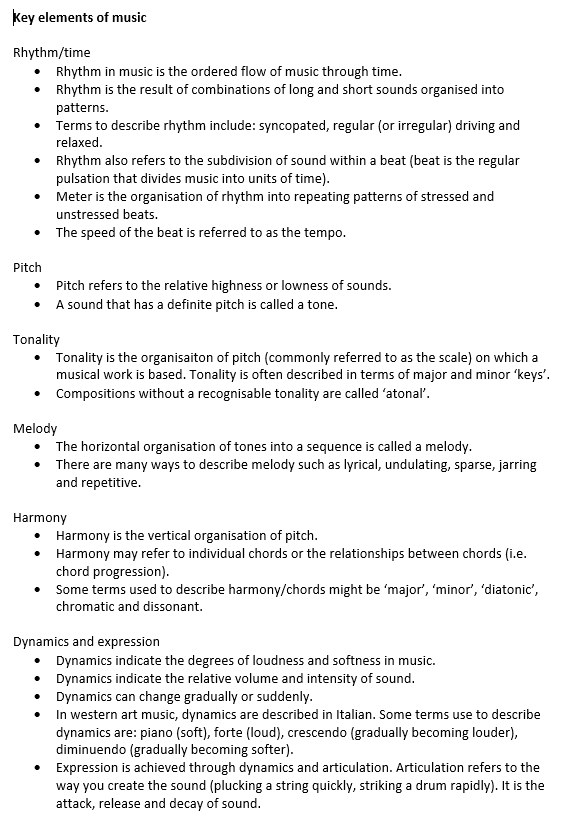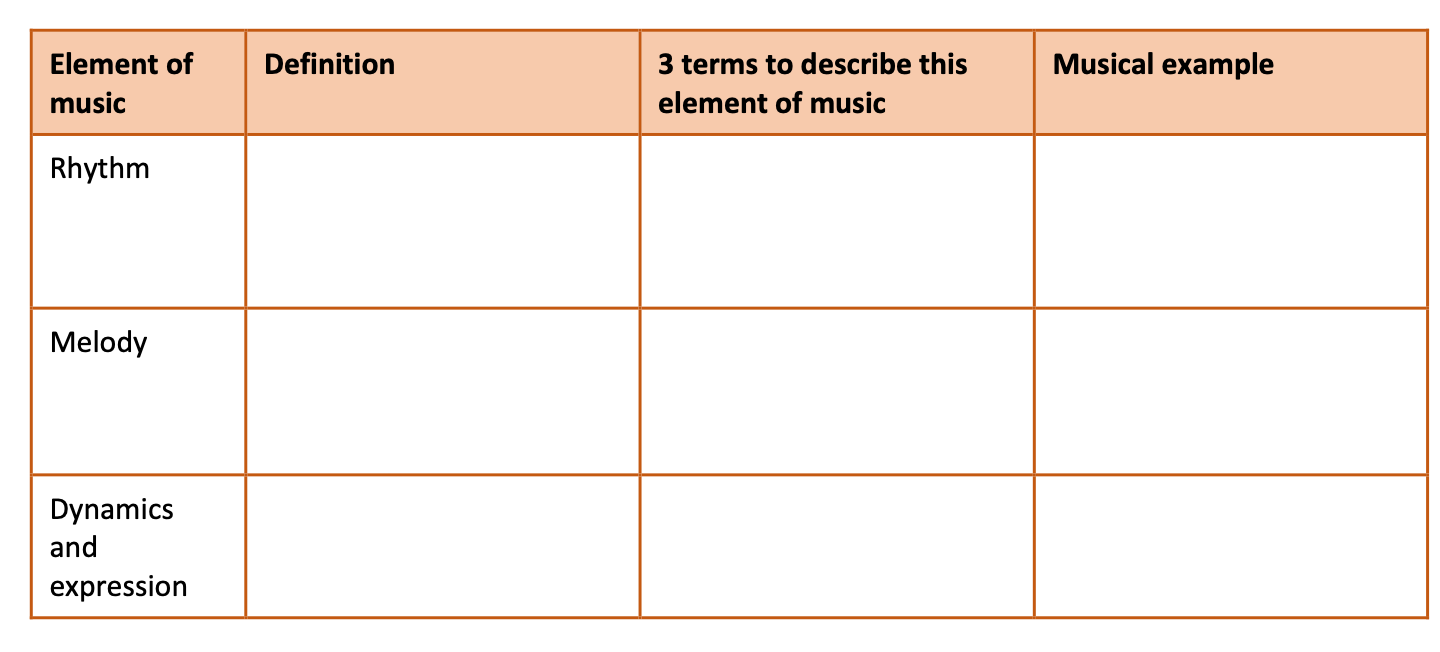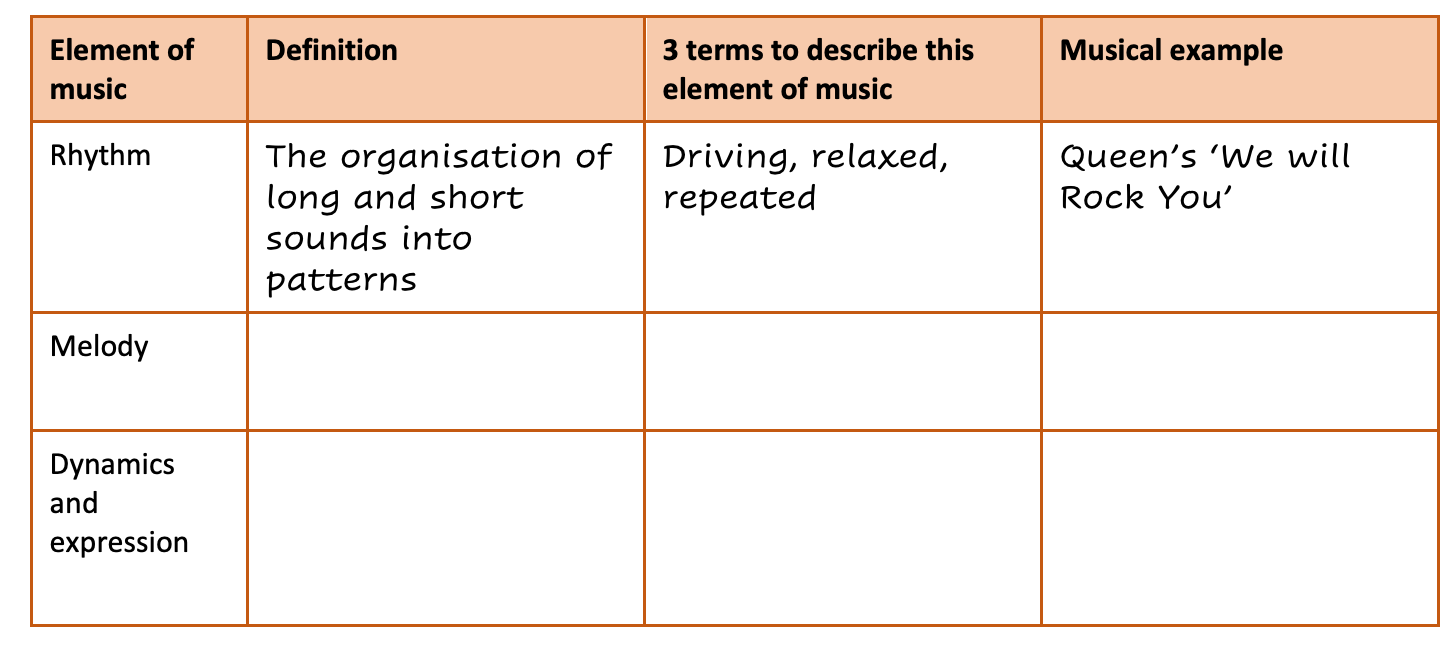In music, students encounter new terms to describe the sound and their aural, listening experiences. This ranges from terms to describe note length and pitch including notation, to conceptual categories such as the elements of music (Kamien, 2010.
VCAA, n.d.). As students engage with the music curriculum, they gain an increasing depth of understanding of these terms and develop their language to describe music. Building students musical vocabulary allows then to engage in deeper analysis of aural experiences as well as the works that they perform. This leads to a greater capacity for musical expression in their performances.
The key elements of music can be found in the document below. The terms have been adapted from
VCE Music Study Design (VCAA, 2016),
ACARA Arts Glossary (ACARA, n.d.), and Kamien (2010).

Investigating the elements of music
Just as grammar should be taught in context (Derewianka & Jones, 2016), so should the specific language of music. Teachers expose students to the technical and disciplinary language of music through strategies that combine listening, talking, reading, and writing. Once students can identify the elements of music, they are then able to respond to, discuss and evaluate compositions using appropriate concepts and terminology.
The following strategy introduces students to the language of some of the elements of music (VCAMUE033,
VCAMUR038,
VCAMUR045). It requires students to engage in collaborative learning (HITS Strategy 5).
- The teacher presents a selection of terms from the key elements of music in the following table. These terms may also be displayed around the room and available electronically.

- Depending on the level of the students and their prior learning in music, the teacher may work with the students to complete the entire activity or the teacher may model responses and then ask students to complete the rest of the task in pairs.
- With teacher guidance, students locate/research definitions for each of the elements of music and write into the 'definition' column. Students may draw on prior knowledge, print or online resources.
- An alternative is to supply the list of definitions from the materials above jumbled and students match the definition to the element of music.
- Students also insert three terms that could be used to describe each musical element.
- Students provide an example of a piece of music that emphasises or makes use of a particular element. For example, Queen's famous song 'We Will Rock You' makes excellent use of driving, repeated rhythm to generate energy (see below). If the table is available electronically, students can provide a link to a recording of the piece of music they are referring to, if available.
- An alternative to asking all students to complete the table in pairs is to assign each pair one element. After the students have completed their given element, new groups of six students (one for each element) can be formed so students can share their new knowledge and complete the table.

Joint construction of definitions – embodying musical language
Once students have a broad understanding of the elements of music, they can expand their knowledge of each of the elements, and the terms used to describe them. They can do this by jointly constructing definitions.
Joint construction of definitions of these terms allows teachers and students to build an understanding of the relationships between musical sounds and the English language. Joint construction of definitions may occur through teachers and students listening to, performing, discussing, and writing about music together. In this way, the classroom community builds a joint understanding of the meanings of specific terms.
The following strategy draws on experiential learning and embodied pedagogies focusing on building knowledge of the key term 'dynamics' (Bannan, 2010; Vass & Deszpot, 2017). This strategy requires students to:
- listen to dynamics
- speak about the dynamics they have heard
- write a definition for the dynamics.
Given the relational nature of dynamics, providing opportunities for students to hear, discuss and come to a joint understanding of what is meant, for example, by
mezzo-forte as opposed to
mezzo-piano, is essential. This strategy can be adapted for use with any musical term.
To do this:
- The teacher presents students with recorded extracts of music showcasing a wide dynamic range. Some examples could be Carl Orf's
Carmina Burana (choral work) or Hans Zimmer's
Interstellar (film soundtrack).
- The teacher discusses with students the dynamic range of each extract of the music. Added complexity can be developed through discussion of the details of dynamics, for example, which instruments or musical lines, or sections were louder or softer, and the effect of this on mood.
- As students gain increasing confidence hearing distinctions in dynamics, specific musical language (piano,
forte, mezzo-forte,
mezzo-piano,
sforzando,
crescendo) is introduced.
- The class re-creates the dynamics through body percussion activities in small groups, for example creating a crescendo.
- Students write down these words in their workbooks and create their own definitions in their groups. They also write the musical symbols that accompany them (p, f, <, >, etc.)
- In small groups, students use body percussion to create short new works experiencing and demonstrating a range of dynamics for particular musical effects.
- Students prepare to present their composition to the class, the discuss the dynamics they will use for the effects they want to create. In their workbook, students list the dynamics used in their composition and write a brief description in note form about why they made each dynamic choice.
- Before students present their compositions to the class, they explain their dynamic choices orally, and what they want to achieve with this piece.
- After listening to the piece, the class offers each group feedback of the way their used dynamics and the effect created.
By both explaining their musical intentions to their peers before the performance, and then offering feedback on performances, students can use new musical language orally, and practice using these terms in authentic contexts.
Curriculum links for the above example:
VCAMUR038,
VCAMUE040.